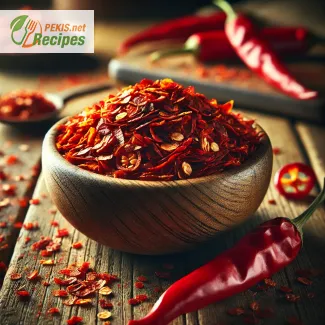
The Ultimate Guide to Red Chili Flakes: Flavor, Benefits, and Culinary Uses
What Are Red Chili Flakes?
Red chili flakes, also known as crushed red pepper, are dried and crushed peppers commonly used as a seasoning in various cuisines worldwide. They add a spicy, pungent flavor to dishes and can range in heat levels depending on the type of chili used. The most common variety is made from dried cayenne peppers, but other types like jalapeño, serrano, and Thai chilies can also be used.
Characteristics of Red Chili Flakes
- Appearance: Small, irregularly shaped flakes with a mix of red and yellow seeds.
- Flavor Profile: Spicy, smoky, slightly fruity with a lingering heat.
- Heat Level: Typically ranges between 15,000 - 50,000 Scoville Heat Units (SHU), depending on the chili variety.
- Shelf Life: Properly stored in an airtight container, they can last up to two years without significant loss of flavor.
Substitutes for Red Chili Flakes
If you run out of red chili flakes, there are several effective substitutes:
- Cayenne Powder: A finely ground alternative that provides a similar heat level.
- Fresh Chili Peppers: Chopped fresh chilies can replicate the spice and heat.
- Chili Powder: Contains a mix of spices but provides a milder heat.
- Paprika: A less spicy option but adds a smoky depth.
- Hot Sauce: Can work in liquid-based dishes as a replacement.
Why Are Red Chili Flakes Used?
Red chili flakes are a versatile seasoning that enhances both flavor and heat in dishes. Their pungent, slightly smoky, and fiery taste complements a wide range of recipes, including:
- Italian dishes like pizza and pasta
- Asian stir-fries and soups
- Mexican cuisine including tacos and salsas
- Barbecue rubs and marinades
- Pickling spices for vegetables
Secrets and Effects of Red Chili Flakes in Cooking
Using red chili flakes in recipes offers multiple benefits beyond just adding spice:
- Enhances Umami: When combined with garlic and onions, red chili flakes amplify savory flavors.
- Boosts Aromatics: Their volatile oils release aroma and spice when heated in oil.
- Balances Sweetness: A touch of spice can counterbalance sweetness in dishes like honey-glazed meats.
- Adds Depth to Sauces: A pinch in tomato-based sauces creates a rich, complex flavor.
- Brings Heat Gradually: Unlike fresh chilies, flakes release heat slowly, allowing a deeper integration into dishes.
Why Red Chili Flakes Are Ideal for Recipes
Their easy incorporation, long shelf life, and measured heat intensity make red chili flakes an essential pantry staple. They allow home cooks to:
- Control spice levels more precisely.
- Enhance flavors in both savory and sweet dishes.
- Quickly season meals without chopping fresh chilies.
How Red Chili Flakes Work
- Capsaicin Activation: The active compound, capsaicin, binds to heat receptors in the mouth, creating a sensation of spiciness.
- Fat-Soluble Properties: Best released in oil-based cooking to distribute flavor evenly.
- Synergistic Effect: When combined with salt and citrus, red chili flakes can heighten taste perception.
Health Benefits of Red Chili Flakes
Consuming red chili flakes provides various health advantages, including:
- Boosts Metabolism: Capsaicin increases thermogenesis, helping in weight management.
- Supports Heart Health: Reduces cholesterol levels and improves blood circulation.
- Anti-Inflammatory Properties: Helps alleviate pain and inflammation.
- Aids Digestion: Stimulates digestive enzymes and improves gut health.
- Rich in Vitamins: Provides vitamin A, C, and E, which support the immune system.
Growing Red Chili Peppers for Flakes
If you want to make your own red chili flakes, growing chili peppers at home is an excellent option.
Climate and Soil Requirements
- Temperature: Requires warm temperatures (70-85°F / 21-29°C) for optimal growth.
- Sunlight: Needs full sun exposure (6-8 hours daily).
- Soil: Well-draining, loamy soil with a pH of 6.0-6.8.
- Watering: Moderate watering; avoid overwatering to prevent root rot.
Growing Process
- Sowing: Start seeds indoors 6-8 weeks before the last frost.
- Transplanting: Move to outdoor soil or containers when temperatures stay above 60°F (16°C).
- Fertilization: Use a balanced fertilizer every 2-3 weeks.
- Harvesting: Peppers are ready for drying once they turn deep red.
- Drying: Air dry or use a dehydrator at low temperatures until crispy.
Additional Insights About Red Chili Flakes
- Storage Tips: Keep in an airtight container in a cool, dark place to preserve potency.
- Common Misconceptions: Some believe all red chili flakes are the same, but heat levels vary significantly based on the chili variety.
- Culinary Pairings: Best combined with garlic, lemon, honey, soy sauce, and herbs like basil and oregano.
Red chili flakes are a versatile, flavorful, and beneficial ingredient that enhances a variety of dishes. Their unique ability to balance flavors, enhance depth, and offer health benefits makes them a staple in global cuisines. Whether you grow your own or buy pre-made flakes, they are an excellent addition to any spice collection. If you're looking to elevate your cooking, red chili flakes are an essential ingredient worth incorporating into your kitchen routine.